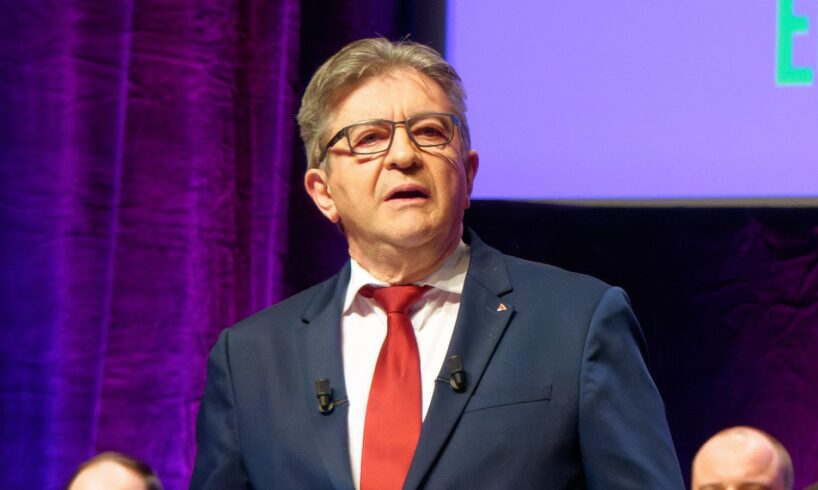
New York City Democratic mayoral candidate Zohran Mamdani speaks at a campaign rally in New York on Monday, October 13, 2025. [AP Photo/Ted Shaffrey]
The election of Zohran Mamdani, a member of the Democratic Socialists of America (DSA), as mayor of New York is an event of international significance. Over a million workers and youth backed his candidacy, despite decades of anti-socialist and anti-communist propaganda in the United States. This reflects a developing radicalization of the working class, marked by growing hostility to capitalism and increasing support for socialism, even as the Trump administration is attempting to impose dictatorship.
Jean-Luc Mélenchon [Photo by Thomas Bresson / CC BY 4.0]
Jean-Luc Mélenchon and France Unbowed (La France insoumise -LFI) hailed Mamdani’s victory, presenting it as a validation of their so-called “left-wing rupture” strategy. In reality, the event is far more a refutation of their perspective. It underscores the appeal of socialism—which Mélenchon dismisses as outdated, instead promoting populism—while the politics pursued by both Mamdani and Mélenchon serve to block a genuine struggle of workers for socialism and for the overthrow of Trump in the US and Macron in France.
Mamdani’s victory unfolded amid acute political crisis in the United States. Trump is consolidating an authoritarian regime, escalating imperialist wars, and mounting an assault on democratic rights. Just ten days before the vote, the “No Kings” mobilization brought together some 7 million people protesting Trump’s bid to establish dictatorship.
Mamdani capitalized on mass hostility to the establishment. He presented himself as a “democratic socialist” advocating tax justice, affordable housing and opposition to the genocide in Gaza. He successfully channeled this wave of indignation, particularly among youth—70 percent of voters under 45 supported him. Yet his strategy is firmly embedded in the Democratic Party, the direct instrument of the American financial oligarchy.
After his victory, Mamdani quickly shifted to the right. He sought to reassure the financial elite and the repressive apparatus, even apologizing to the New York police and praising bankers such as Jamie Dimon. He went so far as to declare his willingness to “collaborate” with Trump in the interests of the city. He is working not to emancipate the working class but to neutralize as much as possible its radicalization.
LFI applauds Mamdani as a political model. Mélenchon and his associates—Mathilde Panot, Clémence Guetté and Manon Aubry—hailed him as an “American counterpart,” claiming to share with him a “concrete and popular” program of rupture with the existing system.
In fact, the lesson of the class struggle in France is precisely the opposite. To fight the dictatorship Trump seeks to erect, the working class must break free from parties that speak of socialism or “the people” while blocking independent mobilization of workers. Only the construction of rank-and-file organizations of struggle, and the fight for workers’ power and socialism, can defeat the capitalist oligarchy as it turns toward dictatorship.
What is Mélenchon’s record? Since his electoral breakthrough, he has systematically steered opposition movements—strikes, the “yellow vest” protests and the mobilization against pension cits—into parliamentary alliances with the bourgeois Socialist Party, the Stalinist PCF, and the Greens. His Nouveau Front Populaire (NFP) does not aim to mobilize the working class for socialism, but to provide an “institutional” outlet stabilizing French capitalism.
Thus, the NFP, through a Socialist Party vote in parliament, recently helped Macron install the massively unpopular Lecornu government. In budget negotiations at the National Assembly, this government refuses to tax the rich, massively increases military spending and prepares sweeping austerity measures against workers.
The leaders of LFI reject any perspective of breaking with the capitalist state, glorifying the bourgeois Republic while refusing to call for a general strike or the construction of independent organs of workers’ power. Mélenchon long ago turned his back on Trotskyism and Marxism, replacing class struggle with rhetoric of a “citizens’ revolution” confined to the national framework, without a fight by the working class for power.
Mélenchon comes out of the Organisation communiste internationaliste (OCI), which broke with the International Committee of the Fourth International (ICFI) in 1971 to ally with the Socialist Party. This meant the integration of the OCI into the framework of French capitalism. He participated in Mitterrand’s “austerity turn” of the 1980s, opening the way to decades of social cuts. Today, his left populism serves the same function: channeling social anger and blocking a turn of the working class towards revolutionary politics.
His alignment with Mamdani and the DSA confirms this continuity. These formations, rooted in the petty bourgeoisie, seek to preserve capitalism by making themselves the arbiters of social protest and opposition. Their aim is to pacify working-class anger, claiming that progressive reform of the capitalist system is possible. But experience proves the opposite: every time they come to power, such movements submit to the demands of the financial oligarchy.
The most glaring case is SYRIZA in Greece. Elected in 2015 on an anti-austerity program and hailed by Mélenchon, SYRIZA immediately capitulated to the banks and the European Union, imposing drastic social cuts and building detention camps for refugees. This betrayal demoralized the working class and paved the way for the return of the right to power.
Such political treachery by the pseudo-left plays a decisive role in the rise of the far right, with figures like Trump in the US or Marine Le Pen in France. By avoiding class confrontation, they disarm workers and allow the far right to strengthen itself by exploiting the social anger provoked by their own policies.
The political record of SYRIZA and Mélenchon is a warning: it is impossible to fight the dictatorial policies of Trump or Macron under the control of forces like Mamdani or the NFP.
Confronting this impasse, the International Committee of the Fourth International (ICFI) and the Socialist Equality Parties (SEP) advance a diametrically opposed orientation. The present situation is producing an objectively revolutionary crisis. The solution lies neither in attempts to reform the Democratic Party nor in constructing electoral fronts with bourgeois parties, like the NFP. It requires the international mobilization of the working class on the basis of a socialist program independent of the pseudo-left and the union bureaucracy.
This program rests on clear principles, such as:
Expropriation of the fortunes of the financial oligarchy and planned redistribution of wealth to meet social needs, not to increase profits.
Irreconcilable opposition to imperialist war and the rise of police-state rule.
Building independent rank-and-file committees in factories, schools, and neighborhoods to coordinate struggles beyond the control of union bureaucracies and unify them nationally and internationally.
Fighting to establish workers’ power and build united socialist states of Europe and across the world.
On this internationalist basis, the class struggle—today channeled by impostors like Mamdani or Mélenchon—can be transformed into a conscious and victorious movement for world socialism. The historic task is not a “left rupture” within capitalism, but a revolutionary break with forces like LFI. Building the ICFI as the new revolutionary leadership is the only viable response to the bankruptcy of world capitalism and the pseudo-left.





